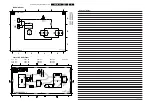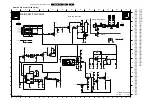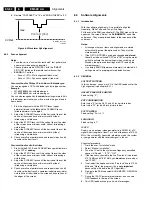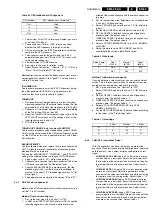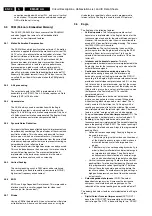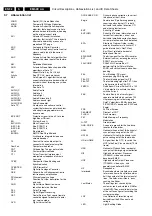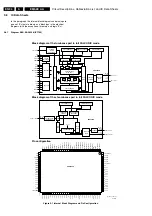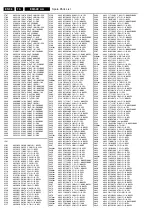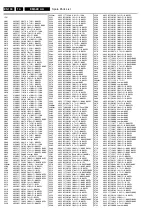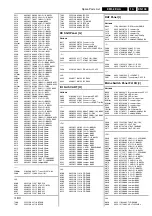
Circuit Descriptions, Abbreviation List, and IC Data Sheets
EN 90
EM5.2E AA
9.
correction combined with a slow PLL, and a small vertical
catch window. This mode enables undisturbed reading of
OSD while the set is tuning.
9.5
FEM (Falconic Embedded Memory)
The FEM IC (SAA4998) is the successor of the SAA4993H,
and adds ”jagged line removal” and “embedded field
memories” as new/improved features.
9.5.1
Motion Estimation/Compensation
The FEM utilizes a high quality motion estimator. The motion
estimation is applied to eliminate the motion blur of current 100
Hz TV sets and to eliminate the motion judder of movies. This
judder is visible on all television sets and even in a cinema.
Particularly for movies (with only 25 pictures/second), the
increased number of pictures helps to smoothen the motion.
These improvements a.o. lead to a picture performance
improvement on a global scale, with an optimal quality
independent from the received standard (50/60 Hz and/or
video/film) or display mode (field doubling/de-interlaced 1fV).
Especially film judder removal from a 60 Hz input source, the
so-called 3-2 pull down film mode, makes the FEM globally
applicable.
9.5.2
4:2:2 processing
The colour data path in the FEM is implemented in 4:2:2
bandwidth (as in PICNIC). The 4:2:2 mode requires an Field
Memory (FM1) of 16 bits wide.
9.5.3
Upconversion
The FEM is always used in combination with the Eagle.
Therefore, the output is always adapted to the input of the
Eagle. This 2fV/4fH signal is motion compensated. Only 3 out
of 4 fields are correct motion compensated. The Eagle will only
use these three correct motion compensated fields.
9.5.4
Dynamic Noise Reduction
For signals that have been affected by noise, improvement can
be achieved by combining of the pixel values of the current and
past fields of video. This is however only possible for those
picture areas in which no movement occurs. If movement
occurs in some area, only the information from the current field
of video may be displayed for that area to prevent smearing, so
noise reduction is not effective there.
To reduce loss of detail, the high frequencies can be bypassed.
This can be done because the human eye is more sensitive to
noise with low frequencies. The movement detection is
implemented in the luminance channel and in the colour
channel to reduce artefacts such as smearing.
9.5.5
Vertical Peaking
The vertical peaking circuit in FEM works on de-interlaced
data, resulting in a double resolution (compared to PICNIC)
high vertical frequency enhancement.
9.5.6
EDDI
EDDI is an Edge Dependent De-Interlacer. This improved de-
interlacer, results in smaller jagged lines for video input
sources (not for film sources!).
9.5.7
Strobe
Having a FEM in the data path, it is easy to create a still picture
or freeze feature. A frame can be frozen once, or, using the
strobe feature, repetitively after a certain programmable
interval of time. The Eagle is used to make “still pictures”.
9.6
Eagle
The Eagle has the following features:
•
Vertical upscaler.
Two fully programmable vertical
upscalers are implemented in the Eagle chip, one for the
luminance signal, and one for the colour difference signals.
However, the number of output lines is never allowed to
exceed 1024 lines per field including blanking. This means
that 1050i/1250i is still possible.
•
Vertical Zoom.
The vertical zooming is done with the
vertical upscaler of the Eagle instead of using the FEM
upscaling. Zoom factors varying from 1 to 8 can be
selected. Vertical compression is possible in 1fV up to a
factor of 2.
•
Interlacer and horizontal upscaler.
Two fully
programmable horizontal upscalers are implemented in the
Eagle chip, one for the luminance signal, and one for the
colour difference signals.
•
Continuous horizontal zoom/compression.
The
horizontal zooming is done with the interlacer and
horizontal upscaler of the Eagle instead of the PICNIC
upscaling. In the Eagle, a digital sample rate converter can
provide horizontal video compression up to 50 %, and up
to 8 times zoom. In compress mode, a part of the screen
remains unused. In this case, parts of the display can be
filled in with a grey value, a colour, or other signal source
that bypasses the Feature Box (TXT or another
compressed picture).
•
Panorama.
A panoramic horizontal distortion on the
picture can be applied to make a screen-fitting picture,
without having black side panels, or lost video. This is
mainly used to fit 4:3 pictures in a 16:9 display with a
resulting correct aspect ratio in the middle of the screen
and stretched video at the left and right sides. The inverse
feature is called “amaronap” and can also be applied.
•
Sub pixel
Luminance Transient Improvement
(LTI): The
Eagle contains a horizontal and a vertical sub pixel LTI.
•
Peaking
: In the Eagle both horizontal and vertical
luminance peaking is implemented. The horizontal peaking
equals the peaking of the PICNIC. The vertical peaking is
an addition of two fixed and one 9-taps fully programmable
peaking filters.
–
Horizontal luminance peaking: Peaking in Eagle can
be used in two ways:
a.
The first way is to give the luminance a linear boost
of the higher frequency ranges, which makes no
distinction between small and large details or
edges.
b.
The other way is to use the peaking dynamically, in
order to boost smaller details and provide less gain
on large details and edges. The effect is detail
enhancement without creation of unnatural large
over- and undershoots on large details and edges.
–
Vertical luminance peaking: There are three vertical
peaking filters. Two fixed vertical peaking filter and one
fully programmable vertical peaking filter. The three
filters all have their separate gain setting before the
results are added. To avoid excessive gain settings a
high peak suppression can be set to avoid excessive
output results.
•
Colour dependent sharpness
(CDS): The colour
dependent sharpness circuit increases the luminance
sharpness in saturated red and magenta parts. The
reduction of the normal peaking can be switched “on/off”.
The below given colour features are implemented in all Eagle
chips:
•
Digital Colour Transient Improvement
(DCTI): DCTI
equals the PICNIC DCTI implementation with improved
control range. The DCTI is done with Eagle i.s.o. PICNIC.

